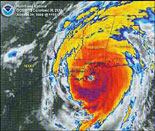On August 29, 2005, the city of New Orleans was visited by the wrath of Nature: Katrina, a category five hurricane. So huge and devastating was she that even now, when people speak her name, there is instant recognition. This was a happenstance so memorable that people even thousands of miles away from the storm remember what they were doing when Katrina hit New Orleans. No wonder such interest is being shown over the Hurricane Katrina Tour.
A Hurricane Katrina Tour will not only reveal the devastating events of the storm, but will give tourists a view of the town's long history. New Orleans, also called The Crescent City and the Big Easy, was a thriving port before the United States was even a dream. Now, New Orleans is the second largest port in the country. The Mississippi River, especially along the levees, those that were breached and those that held, will be a prominent feature of the Hurricane Katrina Tour.
The French beginnings of the city began around 1690, when the territory was claimed for the French crown. The Hurricane Katrina tour Grey Line buses will traverse famous streets that were laid out in 1718 by the Royal Engineer. Bourbon Street was not named after the whiskey, but after the Royal House of Bourbon, then the occupants of France's throne. The Hurricane Katrina Tour reveals the rich heritage of the French Quarter that was largely untouched by the storm, yet profoundly affected all the same.
The Hurricane Katrina Tour provides a fascinating trek through the Big Easy and a chronological tour of events pertaining to the storm. It will be a profound educational experience for the children who remember Katrina, and younger kids who do not. Children absorb history that is presented in an interesting way, and the Hurricane Katrina Tour will teach them like no history book can.
New Orleans has contributed immeasurably to the arts and the Hurricane Katrina Tour will provide a glimpse into this area of the City's history as well. Jazz was born in the French Quarter, and many famous musicians, authors, and people of repute were born in the environs covered by the Hurricane Katrina Tour. Louis Armstrong and Mahalia Jackson learned their music in these very streets. William Faulkner, Truman Capote, Tennessee Williams, and Anne Rice were born here as well. Marie Laveau, the early 1800s Queen of Voodoo, was a native of the French Quarter.
The Hurricane Katrina Tour will reveal natural history as well. Many people in the lower forty eight states don't realize that 30% of all the seafood they eat, specifically fish, crabs, shrimp, oysters and craw fish, comes from New Orleans and its environs. The tour will also address the disappearing coastal wetlands, hurricane destruction, levee protection, and oil and gas pipelines that are vitally important, not only to New Orleans, but to the country as a whole.
Some folks may wonder, isn't it maudlin and sensational to even have a Hurricane Katrina Tour? The answer to those questions is that there is much more to New Orleans' story than of those fateful days and the continuing aftermath. The beginnings of this story has its inception in Washington DC.
When some tragically misguided US Congresspeople started to question whether New Orleans should even be rebuilt at all, the decision was made in New Orleans that it was vital to create a tour that not only informed visitors about the devastation to the city and Southern Louisiana, but to educate about their contribution to the US and global economies. Perhaps the most important lesson to be learned is the resiliency and rebirth of New Orleans and what the human spirit is capable of accomplishing.
Come with us and be informed, entertained, and enlightened. Give your children a chance to see History as it lives and breathes. |

Hurricane Katrina ~ a Category Five Hurricane

New Orleans, The Big Easy
|
|